Holm Akhdar (Special Investigations Unit)
The crime of poaching endangered animals has increased in Yemen during the past few years where wildlife has become a daily, undeclared victim, and witnessed ongoing genocide. The current war in the northern and southern parts of the country has resulted in the absence of control and law regulations and curtailed the role of the environmental authorities.
Consequently, poaching, indiscriminate and iniquitous hunting has flourished, causing some rare species to disappear, and contracting others to the point of extinction.
This special investigation, from Holm Akhdar, reveals that 34 documented murders of rare animals occurred during the year 2020. The investigation also records the number of Arabian leopards poached over the past years, and shows the status of animals in zoos in Yemen.
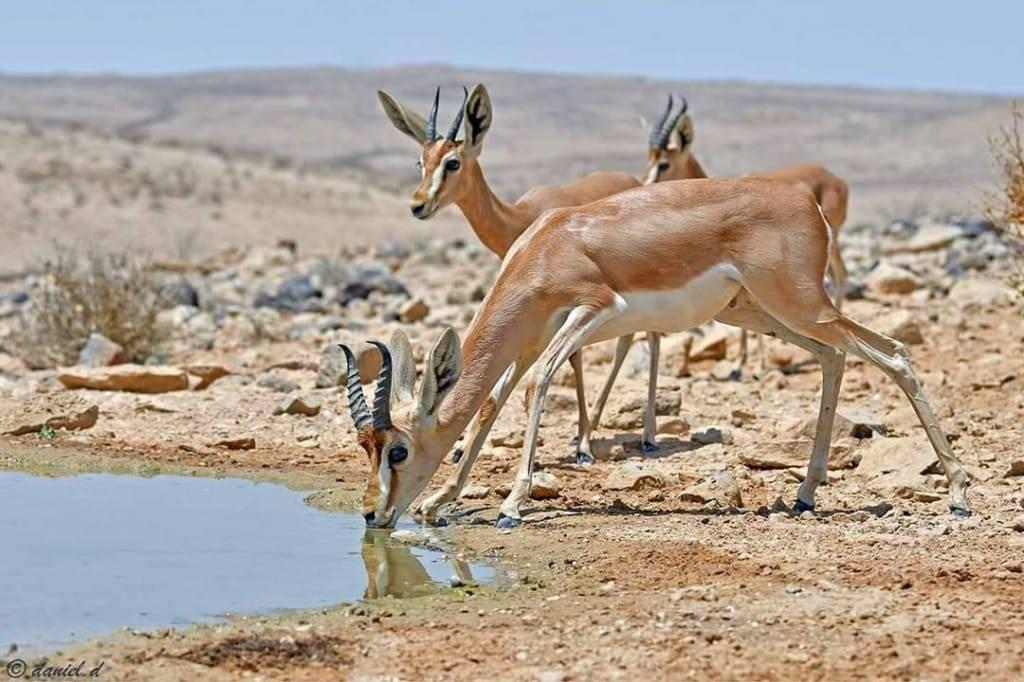
Animal Diversity in Yemen
According to the National Biodiversity Strategy, the Yemeni environment is one of the richest regions of the Arab Peninsula in terms of unique and rare biodiversity. It includes many domestic and rare species of animals, plants, birds, reptiles and others.
Moreover, Yemen has 71 species of wild mammals registered in the records of the Public Authority for Environment Protection. Nearly a third of those mammals are relatively large species, and they are rare in other parts of Arab countries.
As stated in the records of the Environment Protection Authority, wildlife in Yemen contains several mammals such as the Arabian mountain gazelle, ibexes and antelopes, the Arabian leopards, cheetah, hyenas, wolves, the Arab red fox, monkeys (and baboons), the civet cat, a type of hedgehogs, honey badgers, and others.
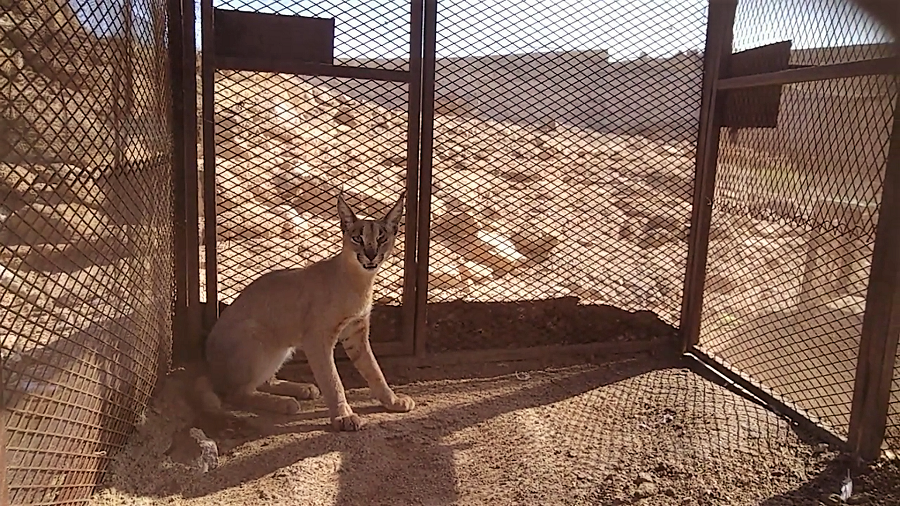
Yemen’s Endangered Animals
The National Strategy of Biodiversity indicates that seven rare mammal species existent in Yemen are currently at risk of complete extinction. They are exposed to poaching, constant killing, and they are being trafficked, with the disregard of the authorities concerned of wildlife protection
Those seven rare mammals have been classified in the IUCN Red List as endangered species, which includes the Arabian leopard, the cheetah, the Arab mountain gazelle, sand gazelle, Dorcas gazelle, the Queen of Sheba gazelle or the Yemeni gazelle (are now extinct in the wild), and Arabian Oryx.
Furthermore, all kinds of rare animals are mostly exposed to poaching and illegal trade operations in Yemeni governorates like: Al-Dhalea, Lahj, Al-Bayda, Shabwa, Hadramout, Ibb, and Socotra Island.
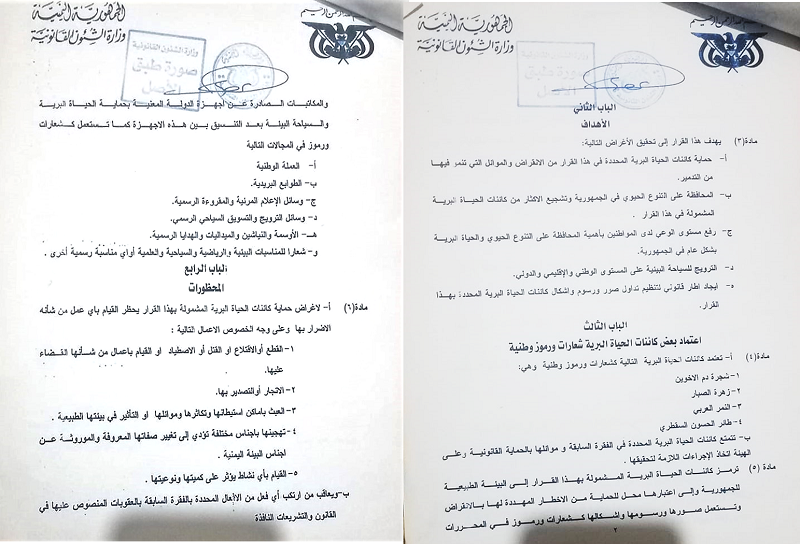
Relevant Laws and Regulations
The total number of Yemeni legislations related to biological diversity amounts to about 21 legislations, including: laws, Republican decrees, and Cabinet decrees. Besides the Basic Law: The Constitution of the Republic of Yemen.
In the Yemeni constitution, Article No. (35) states that “environment protection is the responsibility of the state and society, and it is a religious and national duty of every citizen”.
In 2002, the Yemeni Cabinet Resolution No. (104) approved a bylaw for protecting endangered wildlife species, and regulating the trade in them.
However, despite the prohibition of hunting endangered animals stated in the Yemeni constitution, laws and legislation, a number of official documents and notes in this regard – Holm Akhdar received copies of them – reveal the exacerbation of poaching crimes in the governorates of Al-Dhalea, Lahj, Ibb, and Shabwah.
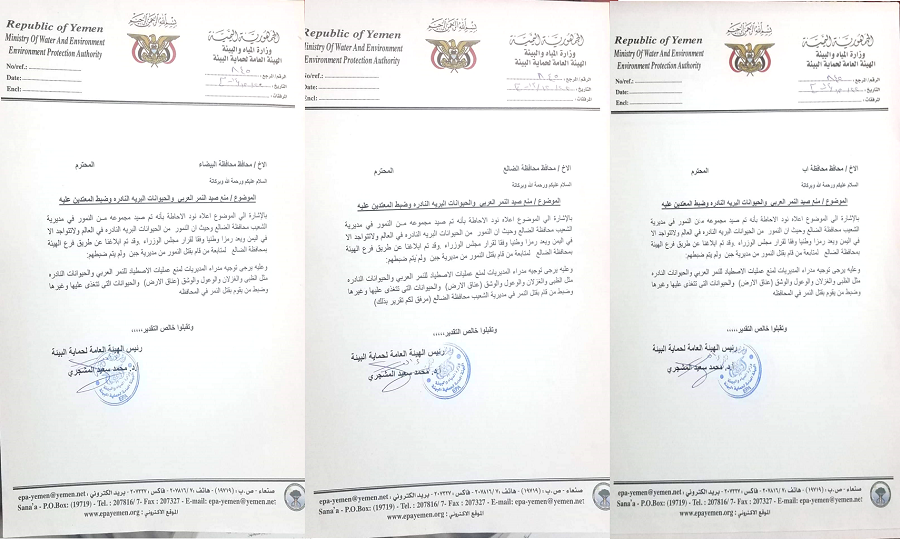

Arabian Leopard: The Most Hunted Animal in Yemen
The Arabian leopard is the domestic animal of Yemen, as it was approved by the Cabinet decree No. (260), 2009, which named the Arabian leopard “the domestic animal of the Republic of Yemen”, and approved it as a symbol of wildlife and national identity.
According to the Foundation for the Protection of the Arabian Leopard, the Arabian leopard exists in Yemen, as it is the most important habitat for Arabian leopards protected by the CITES International Treaty for Wild Animals Protection. The Arabian Leopard is classified as one of the rare and endangered subspecies.
As data from the Public Authority for Environment Protection show, the Arabian leopard lives in many regions in Yemen, namely in the governorates of Al-Dhalea, Lahj, Al-Bayda, Al-Mahrah, Shabwa, Saada, Hajjah, parts of Ibb, and others.
Currently, there are about 40-50 endangered Arabian leopards live inside zoo cages in Yemen, 38 of them are housed in Taiz zoo alone. Hasanah Organization reported.
Nevertheless, a national expert from the EPA in Sana’a confirms that the number of Arabian leopards living in the Yemeni wilderness may be more than the number stated above, if compared to the number of the ongoing crimes that affect dozens of those leopards annually.
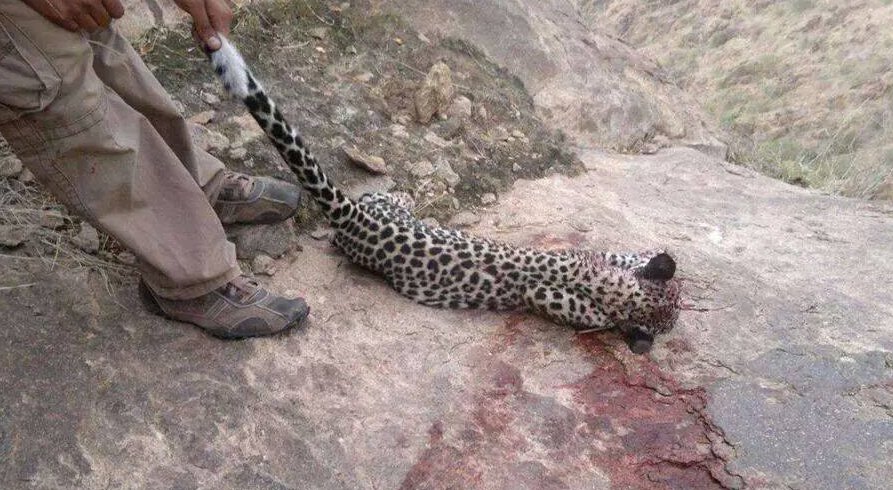

18 Arabian Leopards Killed and 11 Smuggled
The Director General of Biodiversity and Natural Reserves at the EPA, in Sana’a, Engineer Abdullah Abu Al-Fotouh, says in a private interview with Holm Akhdar: “The Arabian Leopard in Yemen is constantly subjected to genocide crimes in certain areas, namely in 3 governorates: Al-Dhalea, Lahj and Al-Bayda, which overlook “the Dabyaniyah Valley”, located between these three governorates.
As for the number of the Arabian leopard killed in Yemen during the past few years, Abul-Fotouh affirmed: “We have monitored and documented 18 killings that the Arabian leopard was clearly subjected to in the areas of Al-Shuaib and Al-Dabyaniya, and the village of “Juban” and “Sadah” in Al-Dhalea”.
In 2011, the Environment Protection Authority recorded that 11 Arabian leopards in Yemen were hunted. Ten of them were smuggled and sold in the Kingdom of Saudi Arabia, and the other one was smuggled to the Emirate of Sharjah in the UAE”. Abu Alfotouh said.


2019: A leopardess and Three Cubs Hunted
At the end of 2019, citizens of a village called “Khubah” in the “Dabyaniya” area, “Juban” district in Al-Dhalea governorate in the south of Yemen hunted a leopardess with her three cubs, after she was besieged in the area.
One of the documents (in this investigation) dated December 30, 2019, issued by the Presidency of the Environment Protection Authority in Sana’a, addressing the deputy governor of Al-Dhalea Governorate, states that “the Arabian leopardess and its three cubs are to be kept and preserved, and not let out of the area until necessary measures are taken”.
In this regard, the official in the Environment Protection Authority, Abdullah Abu Al-Fotouh, says: “The Arabian leopardess was hunted with her three cubs in the village of (Khabah), and as soon as our field team arrived the area, the three cubs were hidden. The huntsmen claimed that they did not catch them, and it was just a rumor. However, we made sure that the incident was real, and the Arabian leopard cubs were caught and hidden, as they are not dangerous, and they are easy to be moved to another area”.
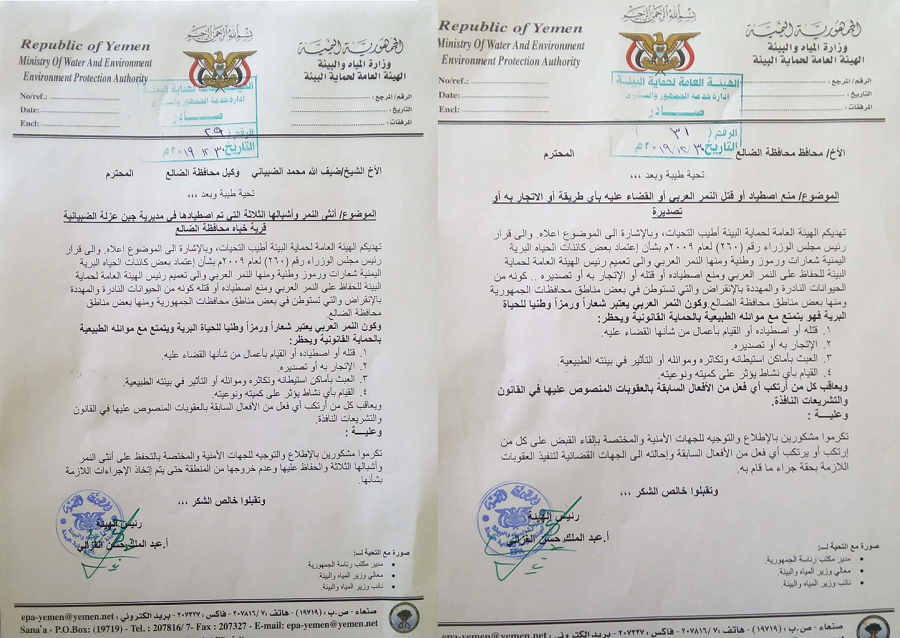
Shabwah: The Most Poaching Area This Year
Shabwah Governorate, located in the middle of Yemen, is one of the areas rich in unique biodiversity, whose habitats are characterized by the existence of endangered wildlife species.
Shabwa’s habitats houses rare animals, namely, in the mountains of “Al-Rawda” district, the areas of “Mayfa’a” district and the mountains of the northern district of “Radom,” as well as the mountains adjacent to “Hajar” area in Hadramout province, in the eastern part of the country
There in Shabwah’s habitat exist, deer, antelopes, and various types of gazelle. The mountain range of “Al-Awaleq Kour” in “Alsaed” district is one of the wildlife environments where a number of endangered species are existent. It is the habitat of the Arabian leopard, wild lynx, and the rare white wolf.
Governor’s Directive to Ban Hunting

On April 7, 2020, the Governor of Shabwah, Muhammad Saleh bin Adiou, officially issued a directive to the chief of the local police in the governorate to ban poaching rare animals in Shabwah’s districts.
This government directive was the first initiative by a Yemeni government official to preserve wildlife during the war period, at the level of both the southern and northern governorates.
In that official document (Holm Akhdar obtained a copy of it), the Governor of Shabwah instructed all security officers in the governorate districts and all security entities to prevent this phenomenon and blacklist all people who carried out these acts”.
34 Rare Animals Killed in 7 Months
Despite frequent endeavors by the local authorities in Shabwah to preserve wildlife, local residents in the mountains and plains were not fully and positively responsive. Since mid-April until today, there have been crimes of hunting and killing for about 34 rare animals of the endangered species in different areas in Shabwah, in nonstop killing acts whose purpose was more damaging than trafficking.
The Director General of the Environment Protection Authority in Shabwa, Mohammad Salem Mujawar, discloses, in a special statement over the phone to Holm Akhdar, accurate details about hunting crimes, and he says: “7 months ago, since we started working at the General Authority for Environment Protection in Shabwa, dozens of verified hunting crimes were documented, either through the reports we received, or through news reports and photos circulated by activists on social media”.
Moreover, 17 Arabian ibexes (6 females, 11 males) were subjected to overhunting in Al-Rawda district. 3 antelopes were also subjected to hunting in the districts of Radhum and Mayfa’a. Besides, about 7 rare deer (3 females / 4 males) were hunted and killed in “Radum” and “Mayfa’a” districts. We also monitored six killings of the Arabian lynx in Al-Saed, and one rare white wolf was killed in Al-Kour Mountains in Al-Saed district, as well. Mohammed Mujawar added.

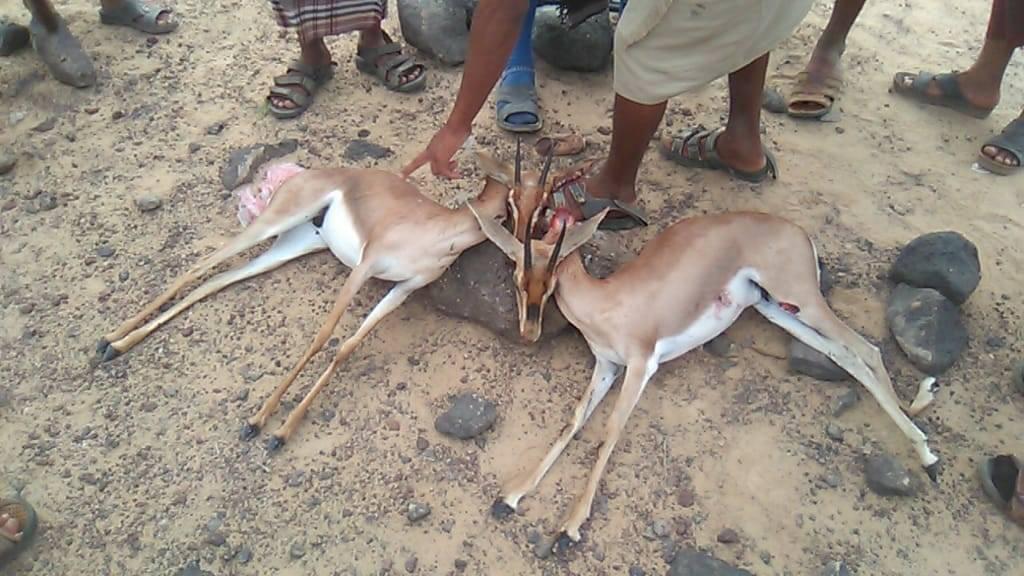
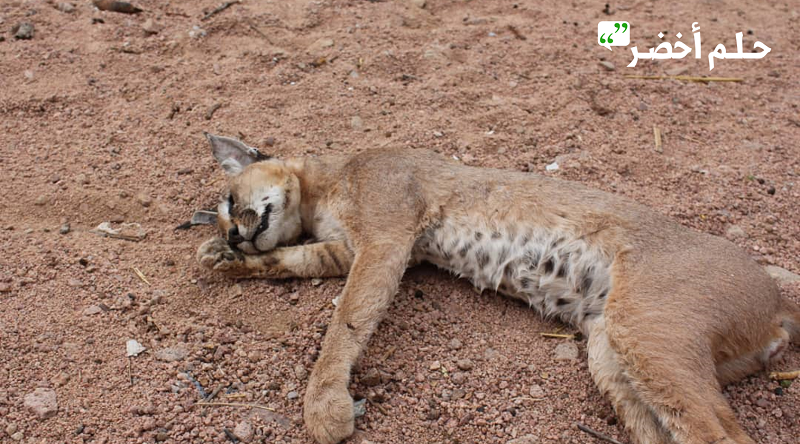

Preservation of Yemeni Wild Animals
There are three zoos in Yemen situated in three Yemeni governorates namely: the capital, Sana’a, Taiz, and Ibb. Those zoos are the only sanctuary for rare and endangered species. The total number of animals in the three zoos is more than 1,460 animals.
The largest of which is the one located in the capital, Sana’a, which includes within its small cages about 1,160 animals of different types of mammals, amphibians and birds. On the other hand, the zoo in Taiz accommodates about 282 animals. Besides, dozens of lions, tigers, hyenas and others are kept in the zoo in Ibb.
In Sana’a zoo, about 31 lions and a number of Arabian leopards, foxes, wolves, cheetahs, baboons, gazelles, antelopes, hyenas and others live in cramped, concrete cages. Most of them were brought from the Yemeni habitat.
As a result of the current conditions Yemen has been through, the zoos in Sana’a, Taiz and Ibb are facing lots of neglect, and constant shortage of food that threatens animals’ survival.
In early February 2016, dozens of animals starved and perished in their cages in the zoo in Taiz due to acute shortage of food as it was announced by the zoo administration at that time.
Press reports also referred to five Arabian leopards and a number of royal lions perished due to famine in Taiz zoo. Meanwhile, some of the predators in the zoo ate each other out of severe hunger, as shown in photos shared by activists on social networks.
As for the zoo in Sana’a, admission fees paid by visitors are the main funding source for the purchase of meat to feed the predators, which in total does not exceed 3 million Yemeni Riyals per month (equivalent to $ 5,000), according to the zoo’s deputy director, Muhammad Abu Awn, in a recorded statement broadcast by the FPA.
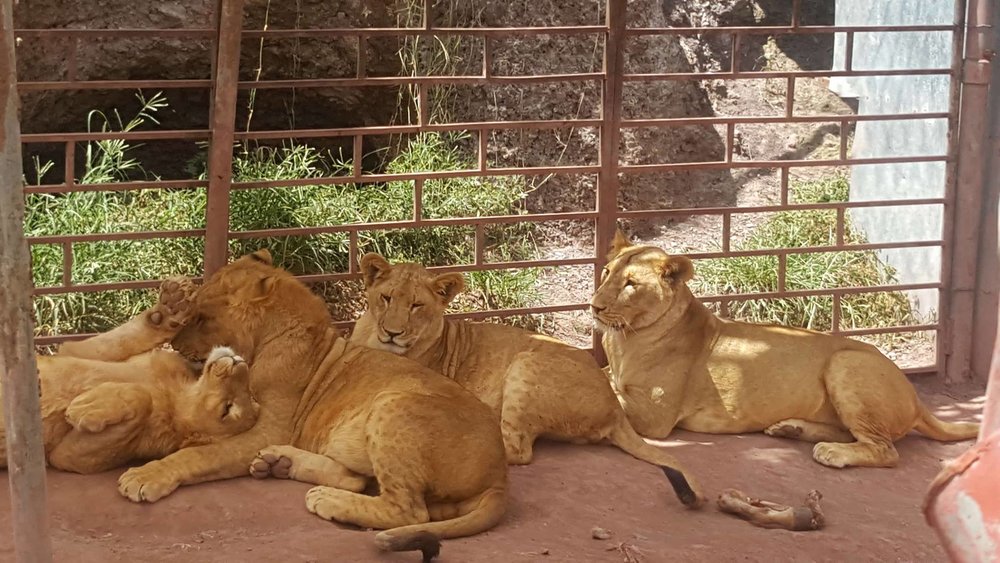
Very Rare Yemeni Lions
The Director of Biodiversity at the Environment Authority, Abdullah Abu Al-Fotouh asserts to Holm Akhdar that: “The lions in the zoos in Yemen are registered as Yemeni lions with the International Union for Nature Preservation, given that they have been in Yemen for more than 100 years. These lions came from “Salah” area in Taiz, and they are among the very rare and endangered species in Africa”.
International Wildlife Bond notes that the lion in Taiz are traced back to the barbarian strain (Atlas Lions), which became extinct from the wildlife in North Africa during the early twentieth century.
Abu Al-Fotouh said: “We approached an international organization interested in animals requesting support for feeding animals in zoos in Sana’a and Taiz and got kind of support from some of those organizations. Even the purebred Arabian horses, whose origins are pure Yemeni, that used to be in horse stables of the Military College in Sana’a, had been receiving food support before the horse stables got bombed and dozens of horses were killed.
On November 27, 2020, OWAP-AR said that about 11 purebred Arabian horses were killed inside the stables, as a result of an airstrike by the Saudi air force on Sana’a, and 20 horses were severely injured, necessitating the need for emergency medicine and food supplies.
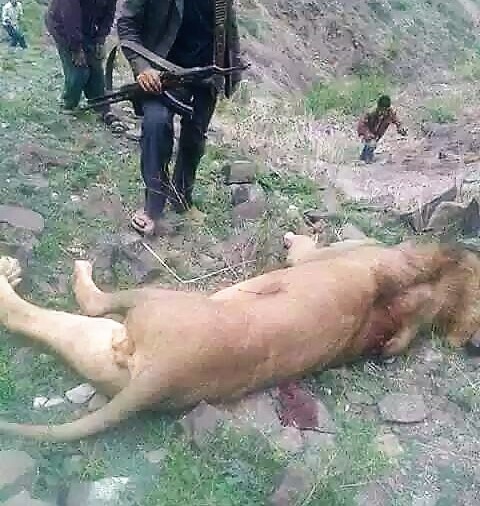
A French Organization Saves Yemen’s Animals
Starting 2016, One World Actors, a non-governmental French organization, has provided constant financial assistance to save zoo animals in Yemen, which have been suffering from starvation and disease since the war began. This French organization, headquartered in Saint-Molf, has mobilized support and fundraised donations to bring food, water and veterinary first aid to more than a thousand of current war innocent victims of Yemeni animals as described by the organization.
Early this year, during the period from January to the end of February, the French organization OWAP-AR applied for licenses to work as an organization operating in Yemen, and requested that it be registered with the authorities in Sana’a and Aden.
The French organization says on its website that it has contributed to “the continuous rescue of animals inside and outside Yemen’s zoos over the past 5 years, and helped more than 310 purebred Arabian horses in the Police College, and saved 230 dairy cows in government farms in Sana’a, Ibb, Dhamar and Hadramout”.
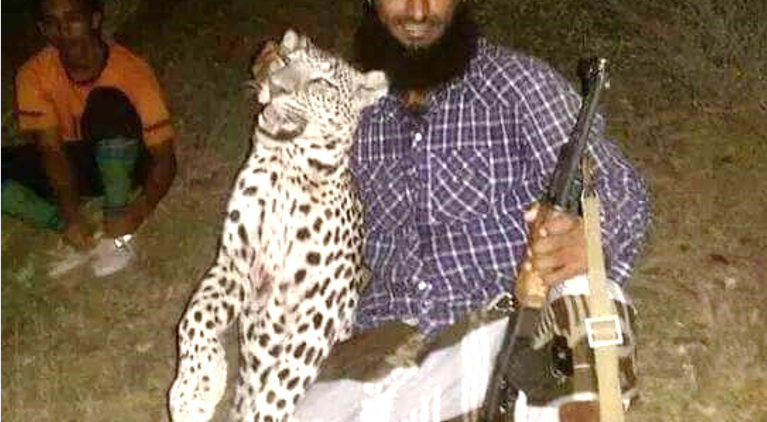
Rare Animal Species Disappear in 20 Years
In light of the above-mentioned data, endangered animals in Yemen’s wildlife seem vulnerable to the threats of poaching and overhunting by hunters and amateur snipers. The cheetah that was existent in Yemen has become extinct, and it hasn’t been noticed or recorded again in studies and researches conducted throughout a decade and a half.
Estimates indicate that Yemen’s rare and endangered wildlife animals may disappear within two decades, if these absurd poaching crimes continue and no serious measures are taken to stop them.
Today, rare species in Yemen’s wildlife are exposed to a hostile war by mankind against all animals due to the loosen grip of the government caused by the ongoing deadly war and conflict in the country. In addition, the absence of official awareness campaign to prevent overhunting, made the task of preserving the endangered species remains unidentified.
Video: Yemen: Poaching crimes on the rise
